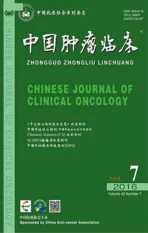三阴性乳腺癌分子分型与异质性的研究进展
2016-05-27张敏综述张瑾审校
张敏 综述 张瑾 审校
·综述·
三阴性乳腺癌分子分型与异质性的研究进展
张敏综述张瑾审校
摘要三阴性乳腺癌(triple-negative breast cancer,TNBC)是指ER、PR及HER-2均为阴性的乳腺癌,占乳腺癌15%~20%。随着基因组学的发展,乳腺癌的分型已不仅局限于基于免疫组织化学的传统分子分型,其中TNBC也被认为是一类异质性疾病,其异质性在分子水平、病理学以及临床特征上也各不相同。因此,对TNBC进一步行分子分型将为靶向治疗带来极大获益,但TNBC分子分型尚无被广泛认可的统一标准,现就最新相关研究做一综述。
关键词三阴性乳腺癌分子分型异质性靶向治疗
雌激素受体(estrogen receptor,ER)、孕激素受体(progesterone receptor,PR)、人类上皮生长因子受体-2(human epidermal growth factor receptor-2,HER-2)均不表达的三阴性乳腺癌(triple-negative breast can⁃cer,TNBC)是乳腺癌研究中的热点。近年来对不同亚型的TNBC是分子遗传学上具有异质性的疾病已有广泛的共识,但目前尚无公认的亚型分类。
1 TNBC分子分型
Lehmann等[1]将TNBC从分子分型上分为6种亚型BL1(basal-like 1)和BL2(basal-like 2)基底样亚型、免疫调节亚型、间充质亚型、间充质干细胞亚型、管腔雄激素受体亚型6种亚型,并且这些TNBC分子亚型表现出截然不同的临床特征。Metzger-Filho等[2]对TNBC的异质性进行了研究,将TNBC细分为基底样型、BRCA相关性亚型、CK和EGFR高表达亚型、Claudin-low亚型、其他病理亚型和免疫系统亚型6种亚型。Burstein等[3]通过基因组分析将TNBC分为腔型/雄激素受体型(luminal/androgen receptor,LAR)、间质型(mesenchymal,MES)、基底样/免疫抑制性(basal-like/immune-suppressed,BLIS)、基底样/免疫激活型(basal- like/immune activated,BLIA)4个亚型。因此,“三阴性”仅仅是TNBC复杂异质性的共同表现,有关TNBC的异质性及各亚型相应的临床、病理特征和个体化治疗方法还有待进一步研究。
2 TNBC各亚型研究进展
2.1基底样型乳腺癌
基底样乳腺癌(basal-like breast cancer,BLBC)与TNBC虽然在临床及生物学特性上有较多相同点,但并非同义词,两者概念相互重叠,BLBC与TNBC重叠比例达60%~90%,TNBC中表达基底样表型的占56%,而在非TNBC中这一比例仅为11.5%[4]。因此,TNBC与BLBC虽然并非完全等同,但密切相关,临床预后均较差,且目前尚缺乏有针对性的系统性治疗。
BLBC的概念是基于基因表达分析,其诊断金标准为基因芯片,然而基因表达谱分析操作复杂且费用昂贵,限制了其在临床上的应用。目前许多研究小组建议采用免疫组织化学检测代替基因芯片来诊断基因组学所定义的BLBC,BLBC定义为基底细胞角蛋白(basal cytokeratins,CKs)中CK5/6和(或)CK14、CK17阳性者[5-6]。
尽管在形态学上BLBC与非基底样TNBC无显著性差异,但两者在某些免疫表型上具有显著性差异,如低氧相关因子(CA9)、神经内分泌标记、p53等。与非基底样TNBC相比,BLBC与BRCA1突变的关系更为密切,具有独特的远处转移模式,且对化疗更加敏感,但预后较差[7]。BLBC与BRCA1突变型乳腺癌有较多相同的生物学特性,BLBC缺乏修复停滞复制叉的能力,这也是BRCA1的功能之一,这也解释了聚腺苷二磷酸核糖聚合酶(poly ADP-ribose polymerase,PARP)抑制剂在BLBC中无法发挥效能的原因,而铂类对DNA损伤丧失复制叉修复功能,可在BLBC中发挥效能[8]。
BLBC通常高表达上皮生长因子受体(epidermal growth factor receptor,EGFR),最近的研究表明叉头框C1(forkhead box C1,FOXC1)转录因子可作为BLBC的重要预后因子及功能调节因子,在BLBC中FOXC1 mRNA及其蛋白水平与EGFR的表达显著相关,同时敲降FOXC1后将减弱EGFR对BLBC细胞增殖、迁移和侵袭的影响,将给BLBC的靶向治疗带来新的方向[9]。
2.2BRCA相关亚型
BRCA基因致病性突变与乳腺癌有关,与TNBC关系更为密切。BRCA1突变携带者的乳腺癌绝大多数(60%~80%)为TNBC[10]。BRCA1基因在乳腺癌突变的比例为4%~11%,而在TNBC中为16%~34%[11-12]。
BRCA1基因与DNA双链断裂同源重组修复有关,BRCA1基因功能的缺失,将导致DNA双链损伤修复功能的缺失,增加基因组不稳定性。在TNBC中识别该缺陷将给临床决策带来决定性意义,携带BRCA1突变的TNBC对破坏DNA化学结构的细胞毒性化疗药物(如烷化剂、铂类、丝裂霉素)和放疗可能高度敏感,这为探索基于分子分型的TNBC个体化治疗方案提供了理论基础[13]。最近一项对于TNBC中BRCA1甲基化的研究发现,BRCA1甲基化与疾病进展相关事件的发生率降低显著相关,这表明BRCA1甲基化将带来较好预后,同时对破坏DNA化学结构的细胞毒性药物敏感性较高[14]。
BLBC、TNBC和BRCA1相关性乳腺癌之间关系密切。TNBC具有BLBC和BRCA1相关性乳腺癌的大部分特征,三者相互关联,但又不能相互替代。
2.3Claudin-low亚型
Claudin-low(CL)亚型最初被Herschkowitz等[15]所定义,以间叶细胞表型为特征,低表达如紧密连接蛋白(Claudin 3、4、7)及E-钙黏蛋白的细胞间连接蛋白,高表达如CN4及CD79a基因的免疫应答基因,生物学观点认为CL亚型由未分化的上皮细胞组成,代表最原始的肿瘤。
与BLBC相比,CL亚型中TNBC的比例为52%,相对较低,而BLBC中TNBC为76%。但CL与BLBC相似,均表现出较高的基因组不稳定性,存在大量的基因扩增或缺失。在转录水平上CL是低分化甚至未分化的类型,高表达上皮间质转化(epithelial-mesen⁃chymal transition,EMT)相关分子学标记、免疫应答基因以及肿瘤干细胞样特征[16]。
对于CL亚型乳腺癌发生机制及影响因子的探索也是近年的研究热点。近期有研究发现,STAT3在CL亚型乳腺癌的肿瘤干细胞中首先被激活,导致肿瘤的发生发展,因而针对STAT3的靶向治疗将给CL亚型乳腺癌患者带来获益[17]。另有研究报道,利用p53缺失的转基因小鼠模型,使其高表达催乳素,发现在p53缺失的情况下,催乳素将缩短乳腺癌发生的潜伏期,同时三阴性CL亚型肿瘤的比例明显升高,这表明催乳素与p53缺失共同作用促进了三阴性CL亚型肿瘤的发生[18]。
2.4CK和EGFR高表达亚型
EGFR的高表达在大多数TNBC的发生发展中起重要作用。Corkery等[19]研究认为,与HER-2阳性细胞系相比,EGFR在TNBC中表达水平更高,并且经上皮生长因子作用后可发现TNBC细胞系中EGFR的磷酸化。该研究中EGFR的磷酸化可导致包括MEK/ ERK和PI3K/Akt通路在内的下游信号转导通路的激活,引起相关基因的表达,从而抑制肿瘤细胞凋亡,促进肿瘤细胞增殖、转移及血管生成,促进肿瘤发展。因此,EGFR信号通路在TNBC的发生发展中可能起关键作用,并可能作为TNBC治疗的靶点。
45%~70% TNBC存在EGFR基因高表达或扩增,因此TNBC最有可能从抗EGFR治疗中获益。EGFR的单克隆抗体西妥昔单抗在TNBC的细胞实验中亦观察到具有一定的作用效果。乳腺癌转化治疗研究联盟(TBCRC)001多中心临床研究显示,102例TNBC转移性患者,西妥昔单抗联合卡铂治疗组有效率为17%,中位PFS仅2个月,提示预后凶险[20]。美国肿瘤组的一项Ⅱ期临床试验研究显示,在TNBC亚组中伊立替康+卡铂治疗组与伊立替康+卡铂+西妥昔单抗治疗组客观有效率分别为30%与49%[21]。总之,虽然西妥昔单抗治疗TNBC具有一定疗效,但其疗效仍令人失望,因此对其敏感的TNBC亚群患者进行个体化治疗显得至关重要。
2.5免疫系统亚型
最近,一项通过对2 100例乳腺癌患者的荟萃分析发现,对肿瘤侵犯、免疫应答、血管生成、凋亡及增殖等相关基因表达与乳腺癌预后相关性的评估中,TNBC只有免疫应答基因高表达与较好的预后显著相关,其他基因改变并非其独立预后因素[22]。最近的临床研究证实,肿瘤组织中淋巴细胞浸润(tumorinfiltrating lymphocytes,TILs)是TNBC的独立预后因素,TILs者预后较好,TILs每增加10%,局部复发风险降低14%(P=0.02),远处转移风险降低18%(P= 0.04),死亡风险降低19%(P=0.01)[23]。但有研究认为免疫特性是免疫系统亚型癌细胞本身所具有的特性,与免疫细胞浸润的多少无关[3]。除淋巴细胞外,NK细胞在TNBC中具有细胞溶解作用,且与ER阳性乳腺癌相比,TNBC中NK细胞的作用明显增强,因此免疫调节治疗对于TNBC患者的治疗显得更为重要[24]。
目前,对于TNBC药物治疗策略的探索大多集中于研制新的细胞毒性药物或应用现有细胞毒性药物联合分子靶向制剂,免疫治疗的出现将给TNBC患者带来新的希望。
2.6腔型/雄激素受体型
腔型/雄激素受体型是分化程度最高的乳腺癌亚型,该亚型不表达TNBC传统常见的基底样型,而是表达Luminal型上皮的细胞特征、并且雄激素受体(androgen receptor,AR)阳性[3]。这一TNBC亚型可能通过AR通路激活肿瘤生长,故AR有可能成为其治疗靶点。
目前,AR已成为TNBC的研究热点,为探索TN⁃BC更为有效的治疗靶点提供了新的方向。AR抑制剂比卡鲁胺在TNBC某些亚型中被证实具有较好的临床疗效[25]。MDV3100-11研究评估单药雄激素受体抑制剂恩杂鲁胺用于晚期雄激素受体阳性的TN⁃BC患者的Ⅱ期临床试验研究显示,79%患者有AR表达,55%患者AR表达≥10%,AR在TNBC中的表达普遍高于之前的报道,雄激素基因检测阳性(Dx+)者的中位PFS为32周,阴性者(Dx-)为9周,雄激素基因检测阳性者临床治疗效果更为显著[26]。
3 结语
TNBC是一类高度异质性的疾病,目前对其分子分型暂无广泛共识,是乳腺癌研究的热点。基因分子生物学的飞速发展为探索TNBC分子分型和异质性带来了广阔前景。针对TNBC基因组、分子标记物以及生物学行为研究的不断深入,将有助于理解该型乳腺癌的复杂性,鉴别其异质性,从分子生物学角度系统地对TNBC进行合理的分子分型,为TNBC规范化、个体化精准诊疗带来新的思路。
参考文献
[1] Lehmann BD, Bauer JA, Chen X, et al. Identification of human triplenegative breast cancer subtypes and preclinical models for selection of targeted therapies[J]. J Clin Invest, 2011, 121(7):2750-2767.
[2] Metzger-Filho O, Tutt A, de Azambuja E, et al. Dissecting the heterogeneity of triple-negative breast cancer[J]. J Clin Oncol, 2012, 30 (15):1879-1887.
[3] Burstein MD, Tsimelzon A, Poage GM, et al. Comprehensive genomic analysis identifies novel subtypes and targets of triple-negative breast cancer[J]. Clin Cancer Res, 2015, 21(7):1688-1698.
[4] Prat A, Pineda E, Adamo B, et al. Clinical implications of the intrinsic molecular subtypes of breast cancer[J]. Breast, 2015, 24( Suppl 2): S26-35.
[5] Liu LP, Bai J, Wei Y, et al. Clinicopathologic features and immunohistochemistry of the basal-like subtype of invasive breast carcinoma [J]. Zhonghua Bing Li Xue Za Zhi, 2013, 42(2):101-105.
[6] Alshareeda AT, Soria D, Garibaldi JM, et al. Characteristics of basal cytokeratin expression in breast cancer[J]. Breast Cancer Res Treat, 2013, 139(1):23-37.
[7] Alluri P, Newman LA. Basal-like and triple-negative breast cancers: searching for positives among many negatives[J]. Surg Oncol Clin N Am, 2014, 23(3):567-577.
[8] Hill SJ, Clark AP, Silver DP, et al. BRCA1 pathway function in basallike breast cancer cells[J]. Mol Cell Biol, 2014, 34(20):3828-3842.
[9] Jin Y, Han B, Chen J, et al. FOXC1 is a critical mediator of EGFR function in human basal-like breast cancer[J]. Ann Surg Oncol, 2014, 21 (Suppl 4):S758-766.
[10] Waddell N, Arnold J, Cocciardi S, et al. Subtypes of familial breast tumours revealed by expression and copy number profiling[J]. Breast Cancer Res Treat, 2010, 123(3):661-677.
[11] Sharma P, Klemp JR, Kimler BF, et al. Germline BRCA mutation evaluation in a prospective triple-negative breast cancer registry: implications for hereditary breast and/or ovarian cancer syndrome testing[J]. Breast Cancer Res Treat, 2014, 145(3):707-714.
[12] Tung N, Battelli C, Allen B, et al. Frequency of mutations in individuals with breast cancer referred for BRCA1 and BRCA2 testing using next-generation sequencing with a 25-gene panel[J]. Cancer, 2015, 121(1):25-33.
[13] De Summa S, Pinto R, Sambiasi D, et al. BRCAness: a deeper insight into basal- like breast tumors[J]. Ann Oncol, 2013, 24 (Suppl 8): viii13-viii21.
[14] Foedermayr M, Sebesta M, Rudas M, et al. BRCA-1 methylation and TP53 mutation in triple- negative breast cancer patients without pathological complete response to taxane-based neoadjuvant chemotherapy[J]. Cancer Chemother Pharmacol, 2014, 73(4):771-778.
[15] Herschkowitz JI, Lubet R. Mouse models of triple negative [basallike/claudin low] breast cancer[J]. Breast Dis, 2010, 32(1-2):63-71.
[16] Sabatier R, Finetti P, Guille A, et al. Claudin-low breast cancers: clinical, pathological, molecular and prognostic characterization[J]. Mol Cancer, 2014, 13:228.
[17] Wei W, Tweardy DJ, Zhang M, et al. STAT3 signaling is activated preferentially in tumor-initiating cells in claudin-low models of human breast cancer[J]. Stem Cells, 2014, 32(10):2571-2582.
[18] O'Leary KA, Rugowski DE, Sullivan R, et al. Prolactin cooperates with loss of p53 to promote claudin-low mammary carcinomas[J]. Oncogene, 2014, 33(23):3075-3082.
[19] Corkery B, Crown J, Clynes M, et al. Epidermal growth factor receptor as a potential therapeutic target in triple-negative breast cancer [J]. Ann Oncol, 2009, 20(5):862-867.
[20] Carey LA, Rugo HS, Marcom PK, et al. TBCRC 001: randomized phase II study of cetuximab in combination with carboplatin in stage IV triple-negative breast cancer[J]. J Clin Oncol, 2012, 30(21): 2615-2623.
[21] Farley J, Sill MW, Birrer M, et al. Phase II study of cisplatin plus cetuximab in advanced, recurrent, and previously treated cancers of the cervix and evaluation of epidermal growth factor receptor immunohistochemical expression: a Gynecologic Oncology Group study[J]. Gynecol Oncol, 2011, 121(2):303-308.
[22] Desmedt C, Haibe-Kains B, Wirapati P, et al. Biological processes associated with breast cancer clinical outcome depend on the molecular subtypes[J]. Clin Cancer Res, 2008, 14(16):5158-5165.
[23] Adams S, Gray RJ, Demaria S, et al. Prognostic value of tumor-infiltrating lymphocytes in triple- negative breast cancers from two phase III randomized adjuvant breast cancer trials: ECOG 2197 and ECOG 1199[J]. J Clin Oncol, 2014, 32(27):2959-2966.
[24] Engel JB, Honig A, Kapp M, et al. Mechanisms of tumor immune escape in triple-negative breast cancers (TNBC) with and without mutated BRCA 1[J]. Arch Gynecol Obstet, 2014, 289(1):141-147.
[25] Gucalp A, Tolaney S, Isakoff SJ, et al. Phase II trial of bicalutamide in patients with androgen receptor-positive, estrogen receptor-negative metastatic breast cancer[J]. Clin Cancer Res, 2013, 19(19): 5505-5512.
[26] Proverbs-Singh T, Feldman JL, Morris MJ, et al. Targeting the androgen receptor in prostate and breast cancer: several new agents in development[J]. Endocr Relat Cancer, 2015, 22(3):R87-R106.
(2016-01-28收稿)
(2016-03-18修回)

Research progress on molecular classification and heterogeneity of triple- negative breast cancer
Min ZHANG, Jin ZHANG
Correspondence to: Jin ZHANG; E-mail: zhangjin@tjmuch.com
The Third Department of Breast Cancer, Tianjin Medical University Cancer Institute and Hospital, Tianjin Breast Cancer Prevention, Treatment, and Research Center; National Clinical Research Center for Cancer; Key Laboratory of Breast Cancer Prevention and Therapy of Ministry of Education; Tianjin Key Laboratory of Cancer Prevention and Therapy, Tianjin 300060, China
AbstractTriple-negative breast cancer (TNBC) is defined by the lack of estrogen receptors (ERs) and progesterone receptors (PRs) and by the human epidermal growth factor receptor 2 (HER2)-negative status. TNBC accounts for 15% to 20% of breast cancer cases. Genomic profiling studies have demonstrated that breast cancer heterogeneity extends beyond the classic immunohistochemistry (IHC)-based divisions. TNBC is also a heterogeneous disease on the molecular level, as well as on the pathologic and clinical levels. Thus, the molecular subclassification of TNBC will be of considerable value to the development of targeted therapies. However, no widely recognized standard for the molecular classification of TNBC exists. This review provides a brief summary on the latest research on TNBC.
Keywords:triple-negative breast cancer, molecular subtypes, heterogeneity, targeted therapy
doi:10.3969/j.issn.1000-8179.2016.07.105
作者单位:天津医科大学肿瘤医院乳腺肿瘤三科,国家肿瘤临床医学研究中心,中国天津乳腺癌防治研究中心,天津市肿瘤防治重点实验室,乳腺癌防治教育部重点实验室(天津市300060)
通信作者:张瑾zhangjin@tjmuch.com.cn
作者简介
张敏专业方向为乳腺癌精准医疗及新辅助治疗的研究。
E-mail:maxine_zhang@126.com
